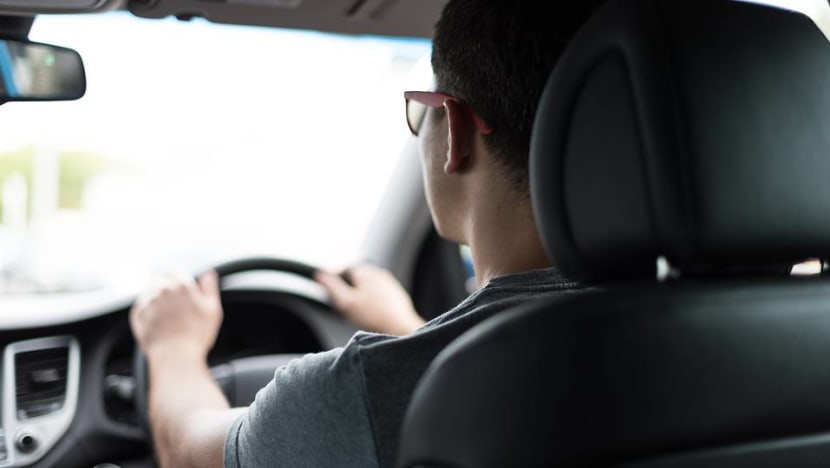‘Have a life besides driving’: Death of private-hire driver a wake-up call, say those in industry
Some say drivers should not feel pushed to clock an unhealthy and unsustainable amount of time on the roads.

A private-hire driver. (File photo: Unsplash)

This audio is generated by an AI tool.
SINGAPORE: The death of 49-year-old private-hire driver Gavin Neo from a stroke in May was a “wake-up call” for those in the industry looking to cash in on working long hours, some drivers say.
Friends said Mr Neo often spent up to 15 hours behind the wheel to provide for his teenage son and daughter.
Private-hire drivers CNA spoke to said that while they have the freedom to choose the number of hours they work, incentive structures set up by ride-hailing platforms - offering cash bonuses for completing more trips - can push them beyond their limits, and should be reviewed.
Others said however that it was also up to the individual to know their physical limits and not blindly chase after cash rewards.
Working long hours for more incentives was precisely what Mr Lincoln Khoo did when he joined ride-hailing platform Grab in January last year.
“For me it was very simple, the motivation to drive long hours is only one thing: Money, income,” said the 40-year-old, who drives part-time and does emceeing and hosting gigs as well.
“The more you drive, you will earn much more."
Under a newcomer incentive at that time, he could get up to S$3,000 (US$2,300) in cash bonuses if he completed at least 200 trips for the first four weeks.
The current newcomer incentive on Grab’s website shows that to get the highest possible cash incentives, drivers have to complete 200 trips per week for four weeks. There are lower incentives for completing 125 rides per week.
What does 800 trips a month look like? Mr Khoo laid out his schedule: A daily 18 hours of driving from Monday to Friday, followed by 26 hours of driving from Saturday afternoon to Sunday -over four weeks.
He said he slept in during all the hours he was not on the road, and took short coffee breaks and washed his face in between drives to keep awake.
For racking up a total of 845 trips in his first four weeks, he earned S$15,000 - S$12,000 from rides and S$3,000 in cash bonuses.
Taking into account expenditures on fuel and rental, he took home about S$10,000 that month.
Was it worth it? Mr Khoo described himself as “the kind of person where if you give me a challenge, I want to fulfil the challenge”.
But he acknowledged it was not a sustainable routine.
After that initial burst out of the blocks, Mr Khoo “took it easy” and drove shorter hours, taking home S$3,000 the next month.
“If you do it continuously for six months, you’ll start to feel the effects.”
HEALTH RISKS
Ms Carmen Ortega has been a Grab driver for 10 years, and on some weekends drives up to 15 hours a day.
The 38-year-old told CNA she has high cholesterol levels, which she believes to be due to her regular consumption of coffee to stay awake during shifts.
She also has chronic pains on her back and neck, from a combination of car accidents and having to carry heavy luggage for passengers.
But Ms Ortega slogs on to earn a living for herself and her ageing parents.
“There is a kind of pressure I give myself … When you are self-employed, every hour you work, you will confirm get paid," she said.
"If I don’t go and work now and go and play, I’ll lose out on this money.
“It’s an internal pressure, that if I take a break to do something else, I will feel guilty,” she added.
But Mr Neo's untimely death, on top of similar incidents over the years, has served as a “wake-up call” to her.
“I have two elderly parents and I am the only child, if anything happens to me it’s my parents (who suffer), not me,” said Ms Ortega.
She has been vocal about private-hire driver issues on her Instagram page @confessionsofagrabdriver, and posted about Mr Neo’s death and his family's situation, calling for donations.
Also deeply affected by Mr Neo’s death was private-hire driver Ishwar Mahtani.
The 63-year-old has had a close shave before, having had a heart attack in 2010 while in his previous job as a business owner.
He held on to that experience when approaching the driving job he has now held for the past eight years.
For one, his working hours are strictly from 10am to 7pm, Monday to Friday, and weekends are off.
“To each his own, but if you have a family and children, then you need to prioritise your time,” he said.
“This case should make drivers take a step back and figure out if this is what they really want.
"Because I can make S$10,000 (a month), but if S$5,000 I give to a doctor, there’s no point right?”
Mr Ishwar still winds up utterly exhausted after a day of driving.
“When I go home, I always tell my family to leave me alone for at least one to two hours, because you are so tired,” he said.
But he makes sure to find time to exercise, doing an hour of brisk walking three times a week, as part of lessons learnt from his heart attack.
“(Previously) my lifestyle was sedentary, my lack of (healthy) diet and lack of exercise,” he said.
Private-hire drivers and delivery riders will soon be able to join associations that have the power to represent them legally and act on their behalf. Singapore's labour movement says it will form new associations to champion these workers' rights and welfare, if Parliament passes the Platform Workers Bill. Nasyrah Rohim with more.
PASSENGER RISKS
Driving long hours can endanger not just drivers.
Some passengers CNA spoke to have encountered private-hire drivers struggling to stay awake during their rides.
Product manager Eugene Tan recounted how earlier this year, his driver appeared to doze off and the car drifted out of its lane several times, on both a highway and a small road.
Alarmed, the 30-year-old offered mints to the driver, who was “appreciative”.
Management professional Nina D’Costa had a similar experience and responded by immediately trying to engage the driver.
“I just made sure to talk to him and varied my volume so that it didn’t become monotonous, and in my head that meant keeping him awake,” she said.
Ms Ortega, the driver, said she prevents such situations by taking a break every three hours; Mr Ishwar said he takes 15 to 20-minute naps at a public car park if he feels sleepy.
“You can’t give your 100 per cent if you don’t just take the break that you need,” said Ms Ortega.
WHAT CAN BE DONE?
Drivers CNA spoke to said top incentives offered by ride-hailing platforms should be more achievable and not require them to put in an unhealthy and unsustainable amount of time on the roads.
Mr Ishwar said there was a period when he would sacrifice family time to drive a few extra hours for the cash bonuses.
“I’ve stopped doing that … I began thinking to myself, ‘I have a life besides driving’,” he said.
“Whose fault is it? On the one hand, if Grab wants more business, they’re going to ask their drivers to drive more, and throw in more incentives. But is this a win-win situation? I don’t think so.”
In the wake of Mr Neo’s death, Member of Parliament Yeo Wan Ling, who is adviser to the National Private Hire Vehicles Association (NPHVA) and National Taxi Association (NTA), said it was an “unfortunate reminder of the significant stresses that many platform workers face, including balancing their rentals and fares”.
In a Facebook post on Jun 3, she urged platform operators to take steps to improve the lives and livelihoods of platform workers by creating fair incentives.
“Avoid schemes that incentivise platform workers to work long hours to get rewards,” she said. “Allow reasonable rest duration for workers to avoid fatigue.”
Some drivers said the ride-hailing platforms were not entirely to blame.
“The drivers themselves should know how to discipline themselves and know what they want,” said Mr Khoo, the driver.
Mr Ishwar said Grab was trying to help drivers make as much as they can. "The drivers themselves have to decide their boundaries,” he added.
Responding to queries from CNA, Grab said it was in contact with Mr Neo's family to provide financial support and assist with insurance claims.
A spokesperson added that Grab was committed to supporting his children through its scholarship and bursary programme.
The firm's incentive programmes are within guidelines set by the tripartite Workplace Safety and Health Council, said the spokesperson.
And on average, the number of hours spent by its drivers who qualify for these programmes are also well within those guidelines, the spokesperson added.
The Council's guidelines encourage drivers, including taxi and private-hire ones, to limit their shifts to no more than 12 hours.
The Grab spokesperson said the company also monitors driver hours and sends in-app reminders encouraging them to take breaks "whenever anomalies are detected".
"We recognise the importance of balancing flexibility with safety initiatives, and we are committed to continue finding ways to encourage safe driving habits," the spokesperson added.
Ride-hailing platform Gojek told CNA its daily incentive system was designed to be “flexible and inclusive”, supporting both regular and occasional driving patterns.
According to Gojek’s website, drivers accumulate points based on the distance of each completed trip, and get daily cash payouts in return.
“This enables drivers to earn rewards on any day they choose to drive, with no lock-in or minimum commitment period,” said the spokesperson.
In response to CNA's queries, ride-hailing app TADA said it supports drivers through feedback sessions as well as fatigue-related app push notifications to remind them to take regular breaks.
A spokesperson also pointed to the firm's zero-commission model, which "enables drivers to take home a larger share of their earnings".
"When we roll out incentives, we would also ensure that they are realistic and achievable for example, completing 20 trips without any complicated pre-qualifiers," said the TADA spokesperson.
"We are committed to continuously exploring ways to support drivers’ health and welfare. For example, we have organised health check-ups in collaboration with the Health Promotion Board, and provided massage sessions during Labour Day as a way to show our appreciation for drivers and care for their well-being."


















